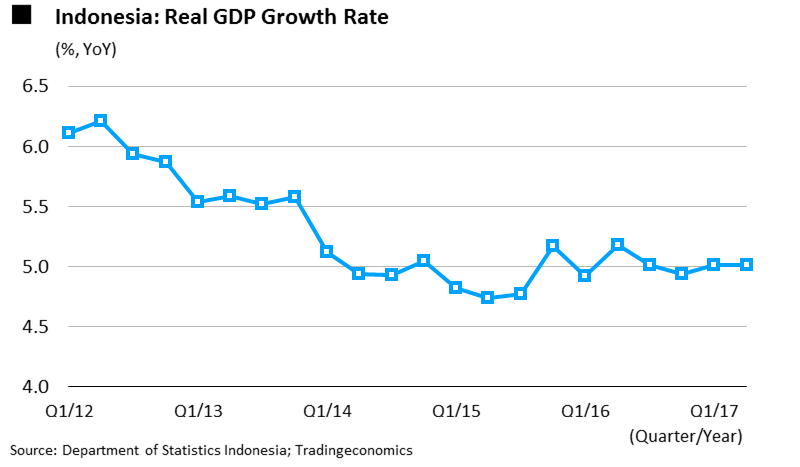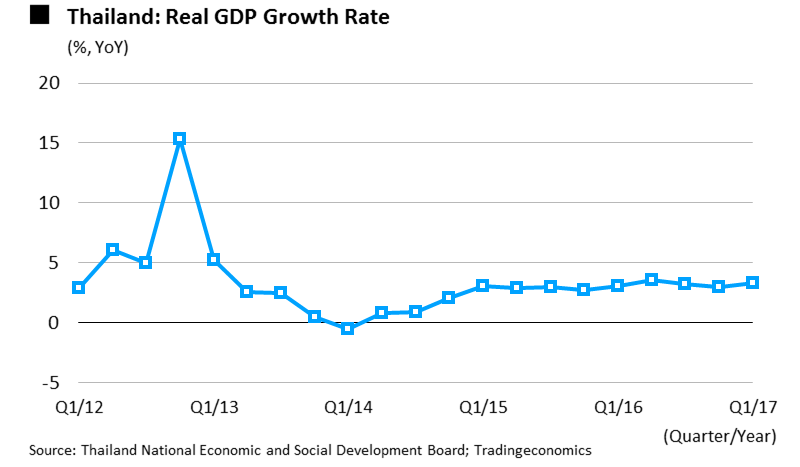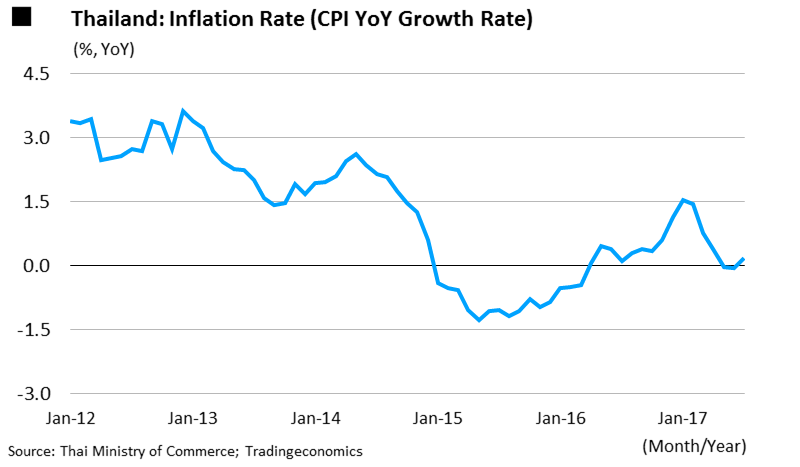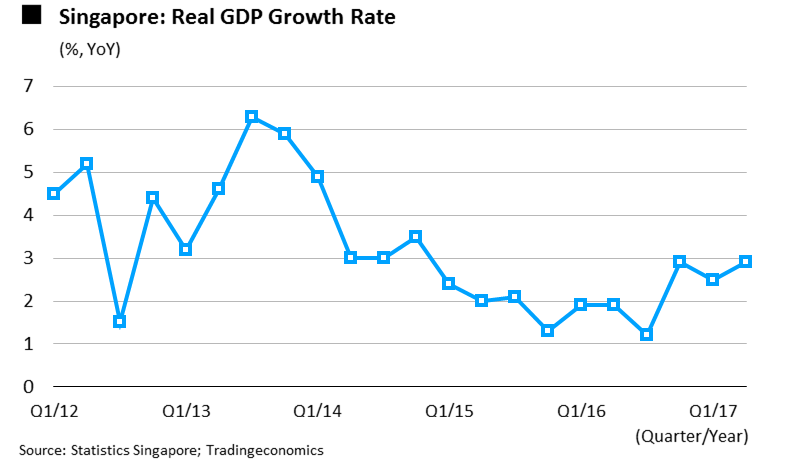ASEAN Macroeconomic Trends: ASEAN Economy Expected to Exhibit Steady Growth in 2H 2017
|
“ASEAN Macroeconomic Trends” is a new series of SPEEDA reports released once every two weeks, compiled by Takashi Kawabata, our Chief Asia Economist. With macroeconomic indicators and financial policies as the fundamentals, the reports look into public economic policies when there are significant moves, as well as political and social issues that may affect economic and business trends. |
|
In the first two weeks of August, several member states of the Association of Southeast Asian Nations (ASEAN) released their macroeconomic indices, with the 2Q real economic growth rates (the real GDP growth rate) of Indonesia and Singapore being especially important. Please refer to the table attached at the end of the report for an overview of the macroeconomic indices for ASEAN economies. This report will focus on and look into the indices and economic policies of Indonesia, Thailand, Malaysia, the Philippines, and Singapore, which released critical indicators during 1–15 August. *Note that the report was first released in Japanese on 16 August. |
|
Indonesia: 2Q Real Economic Growth Rate Levelling Off at 5.0% Indonesia reported 5.01% in its real GDP growth rate on a year-on-year basis for 2Q 2017, levelling off from the same figure recorded in 1Q. The country’s economic growth bottomed out from the 4.74% in 2Q 2015, and is expected to experience a slow recovery in the long term. The country’s business confidence index (BCI) saw positive growth for the first time in two years, and consumer confidence index (CCI) also edged up after a continued downturn for three quarters. Both figures have remained above 100, indicating sound growth. The country raised its full-year GDP growth target to 5.2% from 5.1% in its 2017 budget revision, with continued, steady growth being projected.
However, concerns regarding individual spending have been rising, with the revenue of enterprises in the daily consumables sector showing sluggish growth, despite Indonesia having the world’s fourth-largest population base of 250 million people and its role in driving economic growth until recently. PT Matahari Department Store, a major local company, showed strong revenue growth by 10.8% YoY in 1H 2017, but the pace slowed significantly compared to the 32.0% YoY growth in 1H 2016. Similarly, PT Ramayana Lestari Sentosa, a major retailer that operates the Ramayana Department Store, saw its 1H revenue growth narrow to 9.8% YoY from 24.5% YoY in 2016–17. Mohammad Faisal, executive director of the Center of Reform on Economics (CORE), a local think tank organisation, said that the curbed consumption and rising preference for saving by the middle class amidst a pessimistic view of economic growth are the primary reasons for such sluggish growth in individual spending. Furthermore, Indonesia reported a deficit of USD 5.0 billion in its current account balance for 2Q; the country has been experiencing deficits since 4Q 2011, giving pressure to currency depreciation amidst the economic growth and surging imports. The Indonesian government claims that the deficit level is “manageable”, and it is unlikely that the number will deteriorate further in the long term.
In terms of economic policies, it is worth noticing that the Indonesian government expects to designate 8 special economic zones (SEZs) by the end of 2017. Under the National Medium Term Development Plan (2015–2019), or RPJMN 2015–2019, the country aims to designate 25 SEZs; 11 have already been designated and 2 have launched operations. According to Enoh Suharto Pranoto, Secretary of the National Council for Special Economic Zone, the development of SEZs in Galang Batang, Bintang Island in the Riau Islands Province is steadily progressing. In general, the time lag between when a large-scale project is announced and when it is actually started is long in Indonesia. That said, the project is progressing gradually, albeit slowly. The total public investment reached IDR 221 trillion (USD 16.58 billion) in June 2017, and the amount is expected to hit IDR 726 trillion (USD 54.45 billion) by 2030. |
|
Thailand: Business Confidence on Recovery, Concern Over Consumer Sentiment According to an officer from the Monetary Policy Committee of the Bank of Thailand (BOT), Thailand’s real GDP growth rate (slated for announcement on 21 August) for 2Q is expected to level off from the 3.3% YoY growth rate in 1Q. From July to December, consumer spending is projected to expand, and the tourism industry to improve by 3.7% YoY, with the full-year estimated growth standing at 3.5%, despite flat growth in exports.
As such, the Thai government expects the economy to recover gradually towards the end of the year. Moreover, the country’s BCI continued to exceed 50 for three consecutive months, indicating sound growth. The number of approvals granted to factory establishment and expansion in July increased by 4.4% YoY to 404 cases, and the investment value totalled THB 39.85 billion (USD 1.2 billion), a substantial increase of 31.5% YoY, as per statistics released by the Department of Industrial Works (DIW) of Thailand on 3 August. Nevertheless, individual consumption remains weak at present, with CCI (released on 8 August) on a continued downtrend for three consecutive months since its peak in April this year. Amidst the background is flooding in Northeast Thailand, where agriculture constitutes the major industry, which caused 23 deaths and total damage worth USD 300 million. According to the Department of Disaster Prevention and Mitigation of Thailand, from 5 July to 7 August, a total of 1.8 million people across 44 provinces were affected by the flooding; of them, 1 million people in 10 provinces (9 in Northeast and 1 in Central Thailand) are still suffering from effects, and caution is still required in northeast areas.
Thailand’s inflation rate, or the YoY growth rate of the consumer price index (CPI), has been moderate; July’s CPI edged up 0.17% YoY, shaking off the negative growth that lasted over the past two months. Core CPI growth showed minor acceleration to 0.48% in July from 0.45% in June.
|
|
Malaysia: Development of East Coast Economic Region Accelerating On 7 August, the Central Bank of Malaysia (Bank Negara Malaysia, BNM) announced that its foreign exchange reserves stood at USD 99.4 billion in end-July, which is able to support 7.9 months of retained imports and equivalent to 1.1 times short-term external debts. While the country’s economic indicators suggest an overall favourable trend, the continued sale of USD in exchange for MYR amidst the depreciating ringgit led to a relatively low level of foreign exchange reserves, sparking criticisms against the risks this may cause. Furthermore, the foreign exchange reserves in months of imports exceeded the minimum safety level of six months, but the ratio of the reserves to short-term external debts only surpassed the minimum level of 100% slightly. As such, further attention should be paid to Malaysia’s foreign exchange reserves going forward.
On 7 August, the East Coast Economic Region Development Council (ECERDC) announced that the cumulative investment value in the East Coast Economic Region (ECER) for major industries starting from 2008 has climbed to MYR 109.15 billion (USD 25.11 billion) on a contract basis, nearing the MYR 110 billion goal originally set for 2020 at a faster-than-expected pace. Although the east coast of the Malay Peninsula, especially such states as Kelantan and Terengganu in the Northeast region, lags behind in economic development, the central government was reluctant to venture efforts into this area where Islamic opposition parties have a deeply-rooted influence. That said, the Najib administration has been allocating funds to fuel economic progress in the East Coast in an attempt to enhance the support rate for the ruling party. |
|
The Philippines: 2017 Growth Rate Projected to Reach 6.5–7.5% On 10 August, the Philippine central bank Bangko Sentral ng Pilipinas (BSP) announced the policy interest rate, which has been maintained at 3% since September 2014. Nestor Espenilla, the new governor of the BSP who assumed office in July, expressed that the Philippines’ economy is supported by strong domestic demand and expanding public investments into infrastructure construction, but as the CPI growth rate peaked at 3.4% in March early this year and has since been declining, it is unnecessary to raise the interest rate for now. Based on the BSP’s understanding, the country’s economic prospects will stay rosy with a rapid growth rate and desirable inflation rate.
Furthermore, Ernesto Pernia, director-general of the National Economic and Development Authority (NEDA) also backed this projection, indicating that the economic growth rate of 2H 2017 will surpass 7% on a year-on-year basis, amidst the strong public expenditure and consumer spending. The real GDP growth rate (slated for release on 17 August) for 2Q is predicted to exceed the 6.4% in 1Q, despite falling below 7%, and continue to indicate strong economic growth. It is believed that the country is highly likely to achieve the annual GDP growth rate target of 6.5–7.5% for 2017. Moreover, the Clark Freeport and Special Economic Zone (CFSEZ) is experiencing sound growth; exports amounted to USD 2.40 billion in 1H, up 81.9% YoY, and imports to USD 2.35 billion, up 79.5% YoY, with both demonstrating a substantial increase. The development and promotion of the Clark International Airport and its surrounding areas, which were previously a US military base, is highlighted as a key national policy with an aim to break the overconcentration of resources in Manila; at this point of time, it can be said that this policy is bearing noticeable fruits. |
|
Singapore: 2Q Economic Growth Rate Favourable at 2.9% Singapore released its real GDP growth rate (on a year-on-year basis) for 2Q, and the figure was revised upward to 2.9% from the preliminary value of 2.5%. In line with this, the Ministry of Trade and Industry (MTI) of Singapore also adjusted the lower limit for the country’s full-year GDP growth forecast to 2.0% from 1.0%, with the cap of 3.0% remaining unchanged. The manufacturing sector exhibited astounding growth at 8.1% YoY in 2Q, driving the country’s economic growth. With the global demand for semiconductors rising, electronic components and precision devices have been the driving force for this sector. The service sector also increased by 2.4% YoY, with the financial intermediary, fund management, and insurance industries reported to have performed well. The MTI expects the manufacturing sector to continue to fuel the country’s economic growth in the second half.
|
|
Summary and Key Focus in the Next Report Amongst the ASEAN nations that have released their economic growth rates, Indonesia’s 2Q figure levelled off from its 1Q figure at 5.01%, while Singapore saw accelerated growth at 2.9% in 2Q, compared to 2.5% in 1Q. Thailand expects a gradual recovery in business sentiment given the sound BCI, whereas consumer spending is weakening. The Philippines retained high growth at around 6% with a moderate inflation rate, and its policy interest rate remained unchanged. Additionally, Indonesia and Malaysia are attracting attention due to the clear progress of their respective mid- to long-term economic policies (dates in the brackets are scheduled release dates). The next report will cover the period from 16–31 August and focus on the following indicators in particular. Indonesia: Automobile Sales Volume (July; 16 August), Policy Interest Rate (22 August) Thailand:Policy Interest Rate (16 August), Real GDP Growth Rate (2Q; 21 August) Malaysia:Real GDP Growth Rate (2Q; 18 August) The Philippines:Real GDP Growth Rate (2Q; 17 August) Vietnam:Trade Balance (August; 28 August)  |












